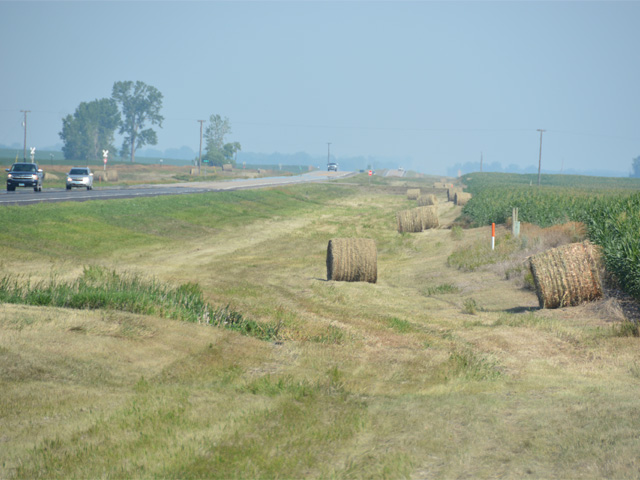Droughty Crops Make Toxic Forage
Consider Toxins When Using Drought-Stressed Crops as Feed
OMAHA (DTN) -- Many producers harvest drought-stressed crops as an additional forage for livestock when Mother Nature scorches other sources and forces the price of alternatives higher.
However, with the severe drought currently in the Northern Plains, the option of using small grains for forage is being threatened by toxins released within the drought-damaged crops. At the top of the list is nitrate poisoning.
The drought has had a devastating effect on all crops in the Northern Plains. Alfalfa and pastures stopped growing due to lack of moisture, leaving livestock producers with little forage, according to Marisol Berti, a professor of forage and biomass crop production at North Dakota State University (NDSU).
Livestock producers are desperate for forage and many are considering using such crops as wheat, barely, corn or oats, she said. These crops have lost their yield potential but could still be used as a forage. For more on how North Dakota crops and farmers are faring, please read "North Dakota Farmers Struggle With Historic Hot, Dry Conditions" here: https://www.dtnpf.com/…
Berti cautions livestock producers to be extremely careful.
"Using these crops for forage is very risky," Berti told DTN. "The main risk is nitrate poisoning as it is very high in wheat, barley, corn and oats."
Nitrate toxicity is the most common toxicity seen in cattle fed drought-affected crops, she said. Nitrates are not typically a problem on rangeland or pastures, but are common in grain crops, especially if high rates of nitrogen fertilizer were applied.
Berti said plants take up nitrate from the soil and convert it into protein. However, when these plants encounter stressful conditions, such as drought, photosynthesis is inhibited, and protein synthesis is halted, increasing the potential for accumulation of nitrates.
Nitrate toxicity is a common problem in ruminant animals, according to Janna Block, livestock system specialist at NDSU's Hettinger Research Extension Center, in a recent NDSU press release (https://www.ag.ndsu.edu/…). Cattle tend to be more susceptible to poisoning compared to sheep, she said.
When beef cattle consume increased amounts of nitrates, it overwhelms the ability of rumen microbes to convert the nitrate to protein, she explained. This results in nitrite building up in the rumen, which is 10 times more toxic than nitrate.
P[L1] D[0x0] M[300x250] OOP[F] ADUNIT[] T[]
Block said the large amount of nitrite is absorbed into the cow's bloodstream, which limits the blood's ability to carry oxygen and causes the animal to suffocate. Lower levels of chronic toxicity may lead to weight loss, night blindness and abortions.
TEST FOR NITRATES
The best way to reduce the risk of nitrate toxicity is to test the forage for nitrate content before feeding it to cattle, Block said.
Many NDSU Extension offices have access to a Nitrate Quick Test, which is a tool to assess if nitrate is present in standing forage.
The Quick Test is not designed to evaluate nitrate content in harvested forages, she said. The best way to test already baled forages is to submit a sample to a laboratory for analysis.
"Producers need to understand the potential risk of nitrate toxicity and the factors leading to nitrate accumulation in plants," Block said. "Determining actual levels of nitrate present in grazed and harvested forages is critical to be able to utilize these feedstuffs in a safe manner."
More information about nitrate toxicity can be found in the NDSU Extension publication "Nitrate Poisoning of Livestock" (https://www.ag.ndsu.edu/…).
BE AWARE OF OTHER POISONS
Berti said many producers in drought-ravaged areas will attempt to harvest grasses and forbs from roadside ditches. Many ditches in the Dakotas are seeded with some amount of sweetclover.
Sweetclover contains high amounts of coumarin, an organic chemical compound. While dry sweetclover is safe, hay baled at high moisture (more than 20%) will likely mold, which causes the coumarin to convert into dicoumarol, a potent toxin.
"Avoid feeding cattle with overwintered bales that contain sweetclover, because they are likely to contain high levels of dicoumarol," Berti advised.
While most forms of sulfur are non-toxic, hydrogen sulfide is highly toxic, she said. A diet or even water with high sulfur contents can increase hydrogen sulfide in cattle, resulting in toxicity. Sulfur can be found in corn gluten, and corn steep liquor from ethanol plants and DDGs.
Producers will need to limit the amount of high sulfur feedstuffs and water to less than 0.3% of the diet dry matter. Water sources can be tested for sulfur content and water with less than 1,000 parts per million (ppm) is considered safe, Berti said. For more on how to identify sulfur poisoning in calves, please read "Watch for These Signs of Feed Toxicity" here: https://www.dtnpf.com/…)
USING SMALL GRAINS FOR FORAGE
With toxicity knowledge in hand, small grains can be a good forage source during drought.
The University of Minnesota Extension Crop News posted a blog titled "Harvesting drought-stressed small grains as forage" where Extension personnel wrote about this subject in some detail (https://blog-crop-news.extension.umn.edu/…).
If a producer's main objective is tonnage, waiting to harvest small grains until the dough stage will maximize yield at the cost of forage quality. Most likely, the hot and dry conditions have already sped the small grains along, with the crop likely already at the boot stage or beyond.
Additional biomass will not accumulate without additional moisture. Drought will likely not have a substantial impact on forage quality compared to conditions with adequate soil moisture, according to the post.
Considering the small grain crop was not a forage crop when herbicides were applied, producers need to double check the labels of products which were applied to be sure of haying restrictions.
Before harvesting drought-damaged small grain crops, producers also need to talk to their crop insurance provider. There are some provisions related to harvesting drought-stressed crops as forages, according to the Minnesota report. USDA's Risk Management Agency recently announced it's relaxing some rules around submitting drought claims and includes instructions on what growers need to do before harvesting an insured crop for forage. (You can read more here: https://www.dtnpf.com/…)
Russ Quinn can be reached at russ.quinn@dtn.com
Follow him on Twitter at @RussQuinnDTN
(c) Copyright 2021 DTN, LLC. All rights reserved.





